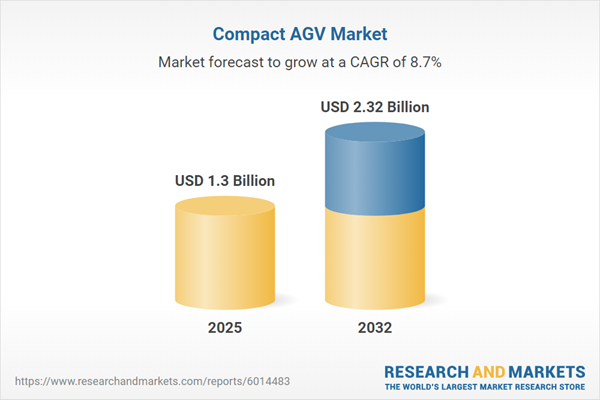Speak directly to the analyst to clarify any post sales queries you may have.
Compact AGVs are becoming integral to digital transformation initiatives and the modernization of industrial and logistics workflows. For senior leaders, identifying future-ready automation solutions is central to maintaining operational resilience and supporting scalable, consistent performance.
Market Snapshot: Compact AGV Market Size and Trajectory
The compact Autonomous Guided Vehicle (AGV) market is currently valued at USD 1.19 billion, with expectations to reach USD 1.30 billion within a year and surpass USD 2.32 billion by 2032. This reflects a compound annual growth rate (CAGR) of 8.68%, propelled by the advance of supply chain automation and the demand for digitalization within industrial settings. Organizations across manufacturing, logistics, and services sectors are implementing compact AGVs to rapidly respond to shifting operational requirements, unlock additional capacity from existing facilities, and improve workflow efficiency. With evolving competitive landscapes and increasing operational complexity, decision-makers are seeking AGV-driven solutions that can adapt to frequent process changes.
Scope & Segmentation Analysis
- Type: Assembly line robots automate repetitive production tasks for increased throughput. Forklift AGVs provide reliable pallet movement, ideal for mixed-speed operations. Towing vehicles enable flexible goods transfer across sites, while unit load carriers enhance delivery consistency.
- Navigation Technology: Inductive and magnetic navigation deliver precise movement along fixed paths, supporting safety and predictability. Laser-based and vision-enabled systems adapt to layout changes and support responsive route adjustments in dynamic environments.
- Load Capacity: Compact, maneuverable AGVs operate efficiently in constrained spaces. Medium-capacity vehicles address broader throughput requirements. Heavy-duty platforms handle higher-load scenarios, supporting workflow continuity during fluctuating demand.
- Application: Compact AGVs drive assembly line flexibility in automotive, streamline material handling in healthcare, accelerate picking and order fulfillment in warehousing, and minimize manual intervention in retail operations.
- End User: Automotive leaders leverage AGVs to optimize production flows. E-commerce firms deploy AGVs for agile order fulfillment. Food and beverage producers rely on automated material tracking, while logistics operators reinforce supply chain resilience through scalable automation.
- Regional Coverage: Growth is observed in North America, Latin America, Europe, the Middle East, Africa, and Asia-Pacific. Each region presents unique regulatory environments, technology adoption rates, and investment priorities, shaping how and when AGVs are implemented.
- Key Companies Analyzed: Companies such as Daifuku Co., Ltd., Murata Machinery, Ltd., KION Group AG, Toyota Industries Corporation, Jungheinrich AG, Mitsubishi Logisnext Co., Ltd., KUKA Aktiengesellschaft, JBT Corporation, GEA Group Aktiengesellschaft, and Omron Corporation are actively contributing to innovation and advancements in the compact AGV sector.
Key Takeaways for Senior Decision-Makers
- Compact AGVs offer significant flexibility, allowing facilities to reconfigure layouts swiftly in response to changes in business models or market demand.
- The integration of AGV fleets reduces manual labor needs and allows more strategic use of valuable production or warehouse floor space, supporting safer operations and higher-value processes.
- Innovations in AGV safety and navigation lower maintenance requirements, which helps minimize unexpected downtimes and mitigate workflow disruptions.
- Centrally managed AGV operations empower organizations to standardize processes across multiple locations and adapt to operational changes in real time, facilitating compliance and efficient resource allocation.
- Sustainability goals can be more readily achieved through AGV deployment by improving resource efficiency, supporting greener operations, and ensuring compliance with evolving regulatory mandates.
Tariff Impact on AGV Value Chains
Shifts in U.S. tariff policies have led AGV manufacturers to diversify supplier relationships and position production closer to primary demand centers. These adjustments increase supply chain visibility and stability, enabling organizations relying on AGVs to maintain procurement certainty despite global trade shifts.
Methodology & Data Sources
This assessment draws from structured interviews with more than fifty industry experts, supplemented by targeted regional case studies and comprehensive secondary research. All findings are aligned with senior management practices and strategic decision-making priorities.
Why This Report Matters
- Delivers tailored intelligence, supporting investment planning and the development of effective automation strategies within logistics and material handling environments.
- Granular analysis of key segments and technologies assists organizations in benchmarking needs and identifying pathways for sustainable automation adoption.
- Provides actionable insights and peer comparison data, helping enterprises accelerate digital transformation across their supply chain functions.
Conclusion
Compact AGVs support the next generation of adaptable supply chain models. This report enables leaders to chart robust automation initiatives, drive efficiency gains, and build lasting agility amid industry transformation.
Additional Product Information:
- Purchase of this report includes 1 year online access with quarterly updates.
- This report can be updated on request. Please contact our Customer Experience team using the Ask a Question widget on our website.
Table of Contents
3. Executive Summary
4. Market Overview
7. Cumulative Impact of Artificial Intelligence 2025
Companies Mentioned
The companies profiled in this Compact AGV market report include:- Daifuku Co., Ltd.
- Murata Machinery, Ltd.
- KION Group AG
- Toyota Industries Corporation
- Jungheinrich AG
- Mitsubishi Logisnext Co., Ltd.
- KUKA Aktiengesellschaft
- JBT Corporation
- GEA Group Aktiengesellschaft
- Omron Corporation
Table Information
| Report Attribute | Details |
|---|---|
| No. of Pages | 198 |
| Published | November 2025 |
| Forecast Period | 2025 - 2032 |
| Estimated Market Value ( USD | $ 1.3 Billion |
| Forecasted Market Value ( USD | $ 2.32 Billion |
| Compound Annual Growth Rate | 8.6% |
| Regions Covered | Global |
| No. of Companies Mentioned | 11 |









